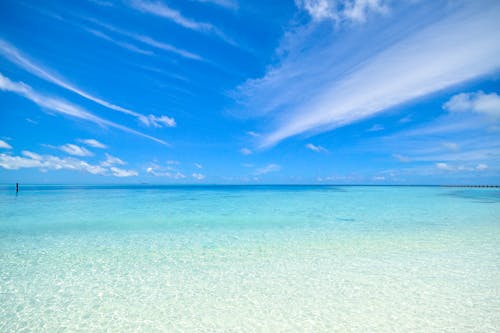WHY IS THE SKY BLUE?
Why is the sky blue?

The typical answer will immediately delve into physics. But at the start that’s not really necessary. Detailed physics will distract us from the simple answer.
The true answer isn’t very complicated. There is no sky. The sky is an illusory surface. “The sky” isn’t colored blue, since, that blue surface up there? It doesn’t actually exist.
Think about it. During overcast days, is our sky colored gray? …Or is it really just the clouds which are gray? And during bright morning fog, is “the sky” white? Or are we just seeing the morning sun shining on white fog? OK then, whenever there’s no fog and no clouds, what up there is colored blue?
Air is blue.
A thick layer of air is a blue-colored substance. And the only thing up there is the air.
When we look upwards, we’re seeing air, we’re looking at brightly-sunlit nitrogen and oxygen. There’s nothing up there but bright blue air, seen against the black of outer space. (Air isn’t perfectly transparent as everyone thinks.) When light shines on air from the side, air is colored bright blue.
On the other hand, air isn’t blue in the way paint and dyes are blue. Instead, air is blue like opals, like blue iridescent soap bubbles, blue jay feathers, blue aerogel. Air has the blue of Morpho butterfly wings, and of blue-colored human eyes. The blue color of sunlit air is a “structural color,” not an absorption-color like paints and dyes. Air is blue because, when light shines upon it, the red-orange part of the light goes straight through, and the blue/violet part is scattered outwards. The same thing happens with aerogels and opal minerals (look through an opal and you’ll see orange.) The same happens with bluejay feathers: the feathers themselves are black, but with a clear opalescent coating, where the coating passes orange light into the black feather below, but bounces the blue light back out. (Bluejays are crow family, with black feathers!) A thick layer of air works the same, but the “black feather” is the black of outer space.
Also, the blue of the air is very weak, a dilute effect, and in order to see it, first we need a very thick layer of air. Ten or twenty miles thick, that’d be good. So, when you look at distant dark forested hills during a clear sunny day, they don’t look green-black. They look foggy blue. You’re seeing the bright-lit blue air in front of them. When you look up at the “sky,” you should be seeing the black of outer space. But instead you’re seeing the foggy blue layer of air that’s in front of the black background.
Above famous NASA photo, showing the blue atmosphere glowing in the sunlight. Imagine diving down into that stuff. It would make outer space appear blue instead of black! You’d still see the moon of course, but it would look foggy blue, against a blue background.
Here’s an odd thought: whenever we look upwards in the late afternoon, we’re actually looking at the horizontal sun-rays passing overhead; rays which fly far to the east. Off in the east they become the red sunset-colors of someone’s evening. From the side, those sun-rays look bright blue. Our blue “sky” above us is actually the portion of blue light that’s missing from someone else’s sunset!
Another odd thought: if you were a giant, a thousand miles tall, standing on the ground, you could bend down and scoop up a handful of Earth’s atmosphere. Hold it out in space, and examine it closely. Against the black of space, it would look like sky-blue smoke! When held in sunlight, it would look like a bright blue gas. But if you poured it out in front of the sun, it would appear bright red-orange. And, if you held your hand 100KM above the earth, its shadow would block the sunlight from shining on the blue atmosphere. People down on the ground wouldn’t see the blue sky there. Instead they’d see a giant black hand-shape, like a hole punched in the blue “sky surface” above them.
Why does air act like this? Why colored blue if light shines upon it, but orange when light shines through it? Why does aerogel do the same? And also cigar smoke? Also, why isn’t the air white, since it scatters light similar to fog or a dust cloud? Now you’re ready for the physics-answers. (But you don’t really need them anymore, since you already know why the sky is blue. Air is blue-colored substance! There is no sky up there, just a thick blue blanket of sunlit air against the dark of outer space.)
Why is the sea blue?
Very simple answer: pure water is a blue-colored chemical.
Water is blue in the same way that paints and dyes are blue. Blue dyes absorb red light and pass blue light. Blue paint does the same. Pure H2O does the same: water is a blue-colored liquid.
But water is slightly weird. Water has a very, very dilute blue color. Water is like sheets of glass, where thin layers appear totally colorless. (You can still see the actual color of glass: just look into the edge of a glass plate. Thin layers of ink also appear colorless, but they have to be incredibly thin layers!)
To see the color of water, first we need a layer of water that’s more than 2 feet thick. Your bathtub at home is too shallow. To see water’s blue color, it takes a meter-deep backyard pool (a pool made of pure white plastic.) Also, as with blue dye, the thicker the layer, the bluer it looks, until finally it looks blue-black, if the layer is thick enough.

The blue color of water becomes very obvious if we view it against a pure white background. Tropical beaches are best for this, where a layer the water is seen against an underwater background of white sand. The deeper the water, the thicker the layer, and the more blue it appears. If you could peel the water off the landscape like jelly, you’d end up holding a giant transparent bright blue layer, with the white sand left behind.
Or, find some photos of indoor swimming pools where the inside of the pool is painted white. Best are photos of white-painted underwater steps, where each step looks more blue, since each step has a thicker layer of blue water above it.
The blue color of water was once a bit controversial. Back in the 1920's - 1930's some physics books insisted that water was blue because of scattering. In other words, the authors believed that, if you dive down deep and look upwards, the sun would look red. They thought that, deep underwater, everything would have a dull red-orange look, same as sunsets. Of course this was back before the invention of Scuba breathing gear and popular widespread experience with underwater conditions. Today everyone can see that the color of water isn’t caused by scattering, because deep under water, everything looks blue rather than red-orange. Yet some authors are still taken in by those older books, and will try to convince you that the blue of water is caused by scattering similar to the blue of opals, or the blue of “the sky.” Nope, wrong. Crater lake is brilliant blue because water, like blue dye, is a blue-colored chemical.
IF YOU THINK THIS ANSWER IS WRONG YOU CAN COMMENT YOUR ANSWER BELOW

COOL BUT CHECK THIS ALSO
ReplyDeleteThere are actually two reasons why the sky is blue. It is blue in the daytime because Rayleigh scattering in air (mainly Nitrogen) scatters more blue light than red and green. So light scattered towards your eyes from the air above you looks blue, while sunlight looks slightly yellow. Very early or late in the day, as the sun gets lower in the sky, it must pass through more air, so late afternoon and early morning light is dimmer, and yellower, than at midday.
However, if only single-event Rayleigh scattering were involved, the sky would turn a dull yellow or brown color at twilight, sunrise and sunset, because so little blue light would reach overhead that only red and green mostly remain. This does not happen, for two reasons:
Firstly some light is scattered more than once, so blue light that has initially been diverted from its path can be scattered again, giving it a "second chance" to reach your eyes.
Secondly, Earth has an ozone layer at around 22km altitude. The ozone layer doesn't scatter much, but it strongly absorbs light in the red and green wavelengths, leaving blue light behind. Because the light of a low sun has to travel a long way through the ozone layer, this absorption has a much stronger impact on the color of the sky at these times, resulting in a dim twilight blue which has a slightly different shade to the daylit sky.